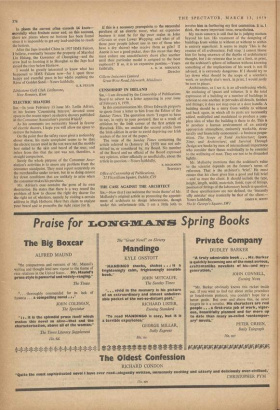THE CASE AGAINST THE ARCHITECT Sin,—Now that I can welcome
the 'main theme' of Mr. Mellanby's original article as promoting the appoint- ment of architects to design laboratories, though under this unfortunate title, I am a little loth to
involve him in furthering my first contention. lt is, I think, the more important issue, nevertheless.
My main concern is still that he is judging matters beyond his ken. His treatment of the designing of buildings from within to without or without to within is entirely superficial. It seems to imply 'This is the essence of all architecture. Full stop.' I cannot blame him for being unaware of the depths of architectural thought, but I do reiterate that to set a limit, in print, on the architect's sphere of influence without knowing something of the implications of his work is not ill advised, it is extremely dangerous. If I should try to lay down what should be the scope of a scientist's work, or anybody else's work, in print, I would justly be torn to pieces.
Architecture, as 1 see it, is an all-embracing whole. An enclosing of 'spaces and volumes. It is the total expression of a building or a number of buildings in relation to one another. It pervades all details, finishes and fittings; it does not stop even at a door. handle. A building should be a unity from within to without and back again, in which all its parts are necessarily added, multiplied and modulated to produce a com- plete idea of what the building is there to do. This is to produce a human environment of an entirely appropriate atmosphere, eminently workable, struc- turally and financially economical—a business propo- sition. The Scope of Total Architecture; Space, Time, and Architecture; and Survival Through Design are books by men of international importance who consider their theses realistically to be essential to the wellbeing of man. They are not to be discarded lightly.
Mr. Mellanby mentions that the architect's value to the scientist depends on the former's terms of reference. That is the architect's 'brief.' He must ensure that his client gives him a good and full brief —and so must the client. It should include the type, height, length, width, materials, finish, type of fittings, position of fittings of the laboratory bench in question. If these specifications are not defined, the 'blatantly silly mistake' may ironically be that of the client.—
Yours faithfully, JAMES K. SCOTT 59a St. George's Square. SW 1


















































 Previous page
Previous page